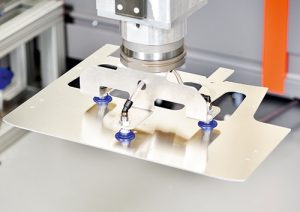 For fabricators, there are three valuable takeaways from the current disruption in the economy. They are (1) the value of diversification of supply chains and industries, (2) the flexibility to adapt to new production requirements and products, and (3) automating to meet customers’ demands. These takeaways are critical to a fabricator’s business viability.
For fabricators, there are three valuable takeaways from the current disruption in the economy. They are (1) the value of diversification of supply chains and industries, (2) the flexibility to adapt to new production requirements and products, and (3) automating to meet customers’ demands. These takeaways are critical to a fabricator’s business viability.
Valuable Takeaway #1: Diversification
Diversification of Supply Chains
With all that has occurred during the past two years with supply chain disruptions from overseas, as well as the current situation, fabricators can no longer rely exclusively on foreign supply chains for fabricated assemblies and parts. If your business model was centered around non-domestic supply chain resources for your fabricated products, then you know exactly what the consequences of that have been.
While there has been much to gain with regard to lower production costs using non-domestic supply chains, the ripple effects from the disruptions over the last two years have cost way more than expected in terms of higher import duties, delays in shipments, and loss of customers due to increased costs.
Diversification of Industries
If your customer portfolio includes supplying to one or more of these sixteen critical infrastructure sectors, then more than likely you have received notification from your customers as to their critical infrastructure status and their continued operations requirements under the Cybersecurity and Infrastructure Security Agency (CISA). As a fabricator and supplier to these critical industry sectors, this notice serves to permit you to also continue limited critical operations regardless of local closure directives.
Valuable Takeaway #2: Flexibility in Manufacturing
We are seeing fabricators draw on their manufacturing ingenuity and flexibility as they quickly convert their existing manufacturing capabilities to fabricate products urgently needed in other industries.
If you are a manufacturer with engineering resources, varied production equipment, and manufacturing expertise, and if you can reach the right contacts, securing new business from industries that you may not have previously served quickly become new sources of revenue for continued viability.
Valuable Takeaway #3: The Power of Automation
During a recent visit to a customer’s facility, the fire alarm went off and fire rescue services were automatically summoned to the building. No one was permitted back in the building for some time. When the ‘all-clear’ signal was finally given and everyone returned, much to their surprise they found that an automated machinery system had continued operating the entire time – loading, producing, and unloading without interruption… because robots don’t recognize fire alarms! Recent business closure mandates have greatly limited labor capabilities unless your business has been recognized by CISA directly, or indirectly, through notice by a CISA approved supplier. What has not been affected is the use of automation to continue producing parts and assemblies.
Even with limited labor resources, those fabricators permitted to continue operating can produce products with the assistance of robots and automation. This allows the fabricator to meet their customers’ needs during very challenging times. Robots and automation systems prove their value again and again, not just in off-shift operations, but during critical labor shortages.
Conclusion: Takeaways Moving Forward
No one could foresee the extreme ramifications of this disruptive pandemic on business as well as everyday life. The valuable takeaways fabricators learn while adjusting to the current environment will serve them well as business, and life in general, return to normal. Certainly, diversifying supply chains, serving diversified industries, adding manufacturing flexibility to meet changing requirements, and utilizing the power of automated technologies to meet customer demands are all great takeaways.
By Frank Arteaga, Head of Product Marketing, Bystronic Inc., Hoffman Estates, IL
Voice.bystronic@bystronic.com
